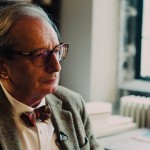Rosman: My own heart goes out to crazy projects like Hempton’s attempt in One Square Inch of Silence. Doesn’t contemporary life (not exclusively, but perhaps more than other periods?) preclude the possibility of Silence? Am I totally wrong in suspecting life is opposed to Silence?
Johnson: Those are two different and difficult questions to unpack briefly. As for your first question — about contemporary life precluding the possibility of Silence more than other periods — I cannot give a definitive answer to that because I am not sure if contemporary life precludes it more than times past. I can only speak to the issues of the day.
Contemporary life as we designed it does indeed seem to make it nearly impossible to find Silence in the way that Gordon Hempton was exploring in his book. In fact, while reading, I noticed as Hempton described his attempts to find places where only natural sounds pervade, he himself drove around the country in cars and flew around in planes that all give off the noise he was complaining about. So I do not think the goal is necessarily ridding ourselves of technology. What Hempton, myself, and others are looking for is not some romantic and nostalgic turn to a Golden Age past. We cannot undo our cultural history. I agree with Charles Taylor regarding the temptation to become nostalgic for past social imaginaries and the fruitlessness of that nostalgia, which he mentions at the end of A Secular Age. The problem though is that for all our luxuries and technical prowess that our current social imaginary allows for, we have now shaped the contemporary world, our work, “leisure,” etc in such a way that is quite limiting and in fact, on some level, harmful to ourselves and others. What we (those gesturing toward Silence) want to point out are the ramifications of lack of silence and what is missing.
For instance, an upcoming documentary by Patrick Shen (see my interview with him here), entitled In Pursuit of Silence (inspired by a book of the same name by George Prochnik), discusses noise pollution and its negative effects on us both physically and mentally. Silence is something that humans need, but we have trained ourselves more and more to turn to it less and less. In doing so, we have created less and less space for Silence. What was at one point, a given for humans — if we can imagine life before electricity — a lived life embedded in Silence, quiet, and down time — now must be actively pursued. We now have to actively seek Silence. Where is the space for it?
If I want to commune with nature in a walk in the woods in a state park near my house, I can go off to wander the natural trails away from civilization but I hear the sound of traffic from the interstate 3 miles away. I hear chainsaws, leaf blowers and lawnmowers in the distance. I hear planes flying overhead. I cannot just interact with natural settings alone, which we, more and more, are discovering as healing for us. Many of the normal everyday activities of times past had Silence built-in. Now we can do all our everyday activities either plugged into our personal computers/music or surrounded by the noise of technological tools. What Hempton and myself and others want to point out is that if we live our lives in such a way where Silence can and is shut out, not only are there negative environmental effects, but a huge part of what it means to be an embodied human is ignored and erased.
So not only do we have that environmental obstacle of noise pollution that we have created and continue to create and spread, we also have cultural obstacles. As Josef Pieper pointed out in his classic work Leisure: The Basis of Culture, we have abolished leisure with our focus on constant work and striving. Even our “leisure” is not true leisure but more focused on amusements, and entertainments.
A third large obstacle, besides the environmental and cultural ones, is a linguistic/conceptual one. Silence is not truly on our maps any more — and now here I am beginning to turn to the second question you asked. Are you wrong in suspecting that life is opposed to Silence?
To answer your second question, we would need to clarify some things. The first thing to clarify is that there are many types of silence and there have been multiple attempts to analyze and discuss them. I am not trying to talk about (to borrow a phrase from philosopher William Desmond) “counterfeit doubles” of Silence. I am not talking about silence as a Kantian noumenal, or as some post-modern/post-structural limit, or as iconoclasm, or as repression, or as evasion (although I am reminded by my work in the academy and discussion with the post-moderns and post-structuralists that my words are haunted by those things). Many of those types of silences appear in the world and have their influence. Christianity has faced these types of silences and they are discussed in Diarmaid MacCulloch’s most recent book, but they are not what I mean by Silence.
For all our contemporary words about Silence and their variants (like mysticism, contemplation, meditation), it is rare to find anyone talking about “actual Silence” in or out of theological circles. The ones I do find talking about it are many of the poets and fiction writers. For example (and the following is NOT an exhaustive list by any stretch of the imagination), Annie Dillard’s work such as Holy the Firm or Pilgrim at Tinker Creek is saturated with Silence. Christian Wiman’s most recent non-poetry book My Bright Abyss speaks of it. The poet Jane Hirshfield in her book of essays Nine Gates speaks of it. I find that Wendell Berry’s work assumes it. The poet Robert Bringhurst especially in his works The Tree of Meaning and Everywhere Being is Dancing is aware of it and in dialogue with it. The philosopher Karmen MacKendrick in her Immemorial Silence speaks of staying true to Silence in even our philosophy by using philosophy against itself and true to it even in our words by “wrapping our words around spaces without words and leave them wordless.” The philosopher Erazim Kohak in his book The Embers and the Stars, the philosopher David Abram in his The Spell of the Sensuous and Becoming Animal, James Danaher in his book The Second Truth all seem to be doing what MacKendrick is asking about. And of course in many of the ancient and medieval mystical and philosophical texts they are aware of and assuming Silence. There are two contemporary thinkers/writers who I have found the most helpful. The first is the neuropsychiatrist Iain McGilchrist and his work The Master and His Emissary. In that book he uses neuroscience to point to a more robust description of how the mind works and not surprisngly his description correlates to Christian views of the mind engaged in prayer. The second thinker/writer is Maggie Ross. Her works especially her most recent books, The Fountain and the Furnace, Writing the Icon of the Heart, and Silence: A User’s Guide are grounded in years of Christian Silence and truly are master works in my opinion. They resonate deeply with my research and my own personal engagement with Silence. In fact, Maggie and I have exchanged a lot of our own research and ideas over the last few years and I consider myself quite blessed to have our initial professional inquiries evolve into one of warmth and friendship.
Ultimately, what I have discovered and keep discovering, is that the contemporary philosophical and theological language for Silence and contemplation often (but not always!) misses the point. Yes, I understand and even agree with and learn much from the various schools of contemporary philosophy and theology. Many seem to be attempting to make space for Silence in our philosophical/theological thinking as MacKendrick suggests we should, but when I read current academic theology and philosophy I often feel frustrated. Many speak of “silence” but treat it as a category or a word and hence end up speaking of the limits of language which is not identical to Silence.
Silence is an actual practice. One needs to do it and not just think/talk/write about it. Furthermore, one needs to be patient with it because it takes a while to allow Silence to emerge. Once silence is given its space, then it will offer its fruit in its own way at its own pace. Silence will affect our words and experience in ways different to words and linear rationality. It has a more holistic and embodied epistemology, metaphysics, ontology, psychology that is built into it so to speak and it is not within the control of our rational thinking mind. Practitioners, who engage deeply the tradition understand this and communicate it in their writing. Monks of course have always known this. But it is not just for monks and more are saying this. I of course cannot cite everyone doing this work because I have not read every one. But one in this area of study and practice that comes to mind is Carl McColman. He is someone I have come to know who writes about silent prayer and the gifts of monasticism with the focus as an educated practitioner and oblate. His books on Mystical Theology and Contemplation like Answering the Contemplative Call shows an understanding of Silence as essentially a path and one that is not just for monks but for all Christians. I’m sure his new book Befriending Silence will explore this area even further.
The focus of Silence as a practice, a way of knowing is just traditional theology and nothing new really. Humans are capax dei and have access to the divine through part of the Mind (often called the Intellect) that contemplates the divine. The Intellect was called the Divine Sense (Origen) — and can be traced in many other thinkers in the patristic period as Anna N. Williams does in her book of the same name. Through the Intellect, Christian practices of ritual, theology, prayer, thinking, engaged the mind that was capable of being in touch with and even participating with God. In the West, we moved as a culture away from that view of humanity and no longer spoke about a part of the Mind that engaged Reality in this manner. There was a shift in how we viewed the mind and the human person — and the various scholars over the years have given us various people to credit/blame for this shift like Augustine, Anselm, Descartes, Scotus, Ockham, Kant, etc, etc. In any event, we now have a contemporary reduced epistemology limiting us to linear, logical, self-referential reasoning and experience and we have theology, texts, and liturgies that assume a different more robust way of being in the world. There is a war between method and content here. The reduced method of knowing usually trumps and unintentionally it often closes off an entire aspect of a deeply Incarnational life. We could (and often do) end up missing what is being offered.
More and more contemporary theologians/philosophers have pointed to the importance of liturgy/prayer/sacraments to ground Christian thought or they focus on the mystical and apophatic. A few examples are the school of thought labeled Nouvelle Theologie, Catherine Pickstock’s book After Writing and various strands of Radical Orthodoxy, the thinkers engaged in the Theological Turn in Phenomenology, Hans Boersma’s work recovering “sacramental ontology,” Andrew Shanks book What is Truth and his attempts at theological poetics, Rowans Williams work especially his most recent book The Edge of Words based on his Gifford Lectures, etc. It seems to me that the works just mentioned and the many others I didn’t mention in a wide range of theological areas, they all are trying to return Silence back to its rightful place as an essential part of using language well, and for an essential part of engaging our self, others, and God.
This makes sense not just as an abstraction but based on actual embodied living. When we pay attention to our mind we see that there is something more going on that is quite ordinary and that is not on our cognitive maps. Like a blind spot, this gap can easily not be noticed. But once noticed, you can no longer ignore it nor can you attempt to erase! It is an essential piece of proper functioning of the mind. In fact, this blind spot of the mind is analogous to the blind spot in our vision. The end of the optic nerve where it joins the retina forms the blind spot in each eye but it is essential to sight. In this way, blindness is the ground of our vision. So too in the mind, this Silence is an “unknowing” and it is the very ground of our knowing! I’m not speaking of anything strange or exotic at all here. It is just that the map we currently use for navigation in the West is an incomplete one and this has important ramifications for a fully embodied life. For a deeply Incarnational tradition like Christianity, this is essential to clarify.
Now in some academic and scientific circles, to even talk like I have been is to be already guilty of some very bad thinking. For them, this way of approaching this topic is problematic and incorrect and our current cognitive maps are fine. As our knowledge of the brain develops though, there are hints that refer back to a more robust way of engaging the world that we are often blind to because we haven’t been told to look for it. This blind spot is Silence and it is what an embodied Christianity of prayer and self-giving service very traditionally engages. It is what I focus my research and writing on and what The Inner Room is about. We are pointing to the traditional area of contemplation/mystical/wisdom in the tradition and offering a space that gestures in that direction and is careful in the language we use to point to it.
So ultimately, my answer to you is, “No. Life is NOT opposed to Silence.”
Silence as an actual practice — and not as a philosophical concept — is an encounter and as Martin Buber says, “all actual life is encounter.” The challenge, and it seems to be quite a countercultural move and challenge at the moment, is to figure out how to once again allow for this aspect to be part of our lives, our churches, our families, our businesses, etc.











